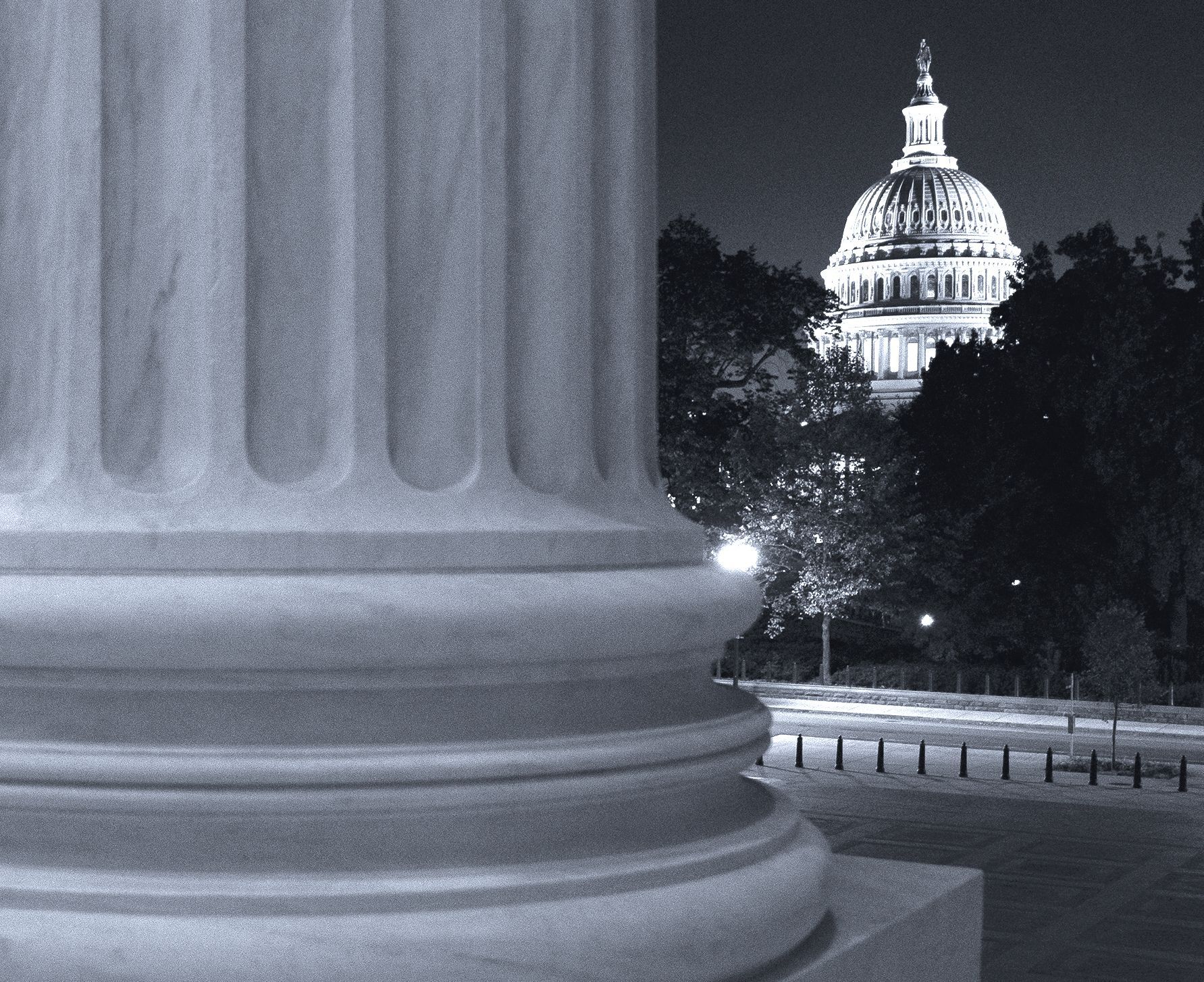
In a decision with far-ranging implications for federal administrative law, the United States Supreme Court issued its long-awaited ruling in Loper Bright Enterprises v. Raimondo (Loper Bright).1 The Supreme Court’s six-Justice majority held that the Administrative Procedure Act (APA) requires courts interpreting agency regulations to determine independently whether the agencies have acted within their statutory authority, even where the statute at issue is ambiguous. In so holding, the Court overruled its 1984 decision in Chevron USA v. Natural Resources Defense Council, which for the last four decades had governed thousands of cases involving federal agency interpretations of ambiguous laws.
Going forward, federal agencies will need to hew more closely to the plain language of any enacting legislation; efforts to interpret statutory language aggressively will face a greater risk of being overruled by the courts. The Loper Bright decision is not retroactive, however, so statutory interpretations previously upheld under Chevron remain in effect.
Below is a summary of the decision and some thoughts on its prospective impacts on antitrust, privacy/consumer protection, and financial regulation agencies, including the Federal Trade Commission (FTC), the U.S. Securities and Exchange Commission (SEC), the Consumer Financial Protection Bureau (CFPB), and the Federal Reserve Board (Fed).
Summary of Decision
The Court’s decision in Loper Bright overruled “Chevron deference,” a long-standing doctrine applying a two-part analysis under which, where a federal statute was “ambiguous,” courts should defer to “permissible” (i.e., reasonable) agency interpretations of the law. As the Court explained, such deference is at odds with the mandate of Section 706 of the APA, which states that “reviewing court[s] shall decide all relevant questions of law, interpret constitutional and statutory provisions, and determine the meaning or applicability of terms”—statutory language not discussed in Chevron itself. Accordingly, courts “may not defer to an agency interpretation of the law simply because a statute is ambiguous.” Rather, it is the courts’ duty to determine the “best” reading of a statute, and “[i]n the business of statutory interpretation, if it is not the best, then it is not permissible.”
In addition to the APA’s text, the Court reviewed historical practice, explaining that from the founding through the rise of the administrative state during the New Deal, courts “underst[ood] that questions of law were for courts to decide, exercising independent judgment.” The APA codified that traditional understanding of the judicial function, and Chevron—without mentioning the APA—“triggered a marked departure from the traditional approach.”
The Court made clear that—both historically and currently—the Executive Branch’s interpretation may deserve “respect,” especially when that interpretation is contemporaneous with the passage of the statute and has remained constant over time. And the Court emphasized that Congress is still able to delegate discretionary authority to an agency, subject only to constitutional limits.
Turning to stare decisis concerns, the Court held that Chevron should be overruled for at least three reasons. First, the underlying reasoning there was based on a fallacious premise—that statutory ambiguities are implicit delegations to agencies—and the Court did not attempt to reconcile its framework with the APA. Second, the Chevron standard has proven unworkable, particularly because “the concept of ambiguity has always evaded meaningful definition.” Chevron was “so indeterminate and sweeping,” the Court noted, that it had “been forced to clarify the doctrine again and again,” “only add[ing] to Chevron’s unworkability [and] transforming the original two-step into a dizzying breakdance.” Third, there is not meaningful reliance on Chevron. The Court highlighted that it “ha[s] avoided deferring under Chevron since 2016,” and lower courts have repeatedly applied it inconsistently, if at all. Neither Congress nor agencies nor litigants know if Chevron will be applied or how the case will come out if it is. And Chevron provides agencies cover to change interpretations. Thus, “[r]ather than safeguarding reliance interests, Chevron affirmatively destroys them.”
Importantly, the Court expressly stated that in overruling Chevron it “d[id] not call into question prior cases that relied on the Chevron framework.” Instead, those cases holding “specific agency actions are lawful … are still subject to statutory stare decisis despite [the Court’s] change in interpretive methodology.” And “[m]ere reliance on Chevron cannot constitute a ‘special justification’ … enough to justify overruling a statutory precedent.”
Impact on Agencies
The Court’s decision in Loper Bright will have an impact on nearly every agency, though some may feel the weight more than others.2 Below are some agencies whose practices and policy goals will likely be affected.
a. FTC
Section 5 of the FTC Act prohibits “unfair methods of competition” (UMC) and “unfair or deceptive acts or practices” (UDAP). The FTC has authority to prevent companies from engaging in UMC or UDAP.
The FTC also has the power to enforce certain statutes. For its competition mission, the FTC enforces the Sherman Act and Clayton Act. For its consumer protection mission, the FTC enforces statutes such as the Children’s Online Privacy Protection Act (COPPA), the Fair Credit Reporting Act, and the newly-enacted Protecting Americans’ Data from Foreign Adversaries Act, among others.
i. Competition
Loper Bright will likely have a direct bearing on the FTC’s current efforts to expand antitrust enforcement through an aggressive agenda that relies on the FTC Act’s prohibition of “unfair methods of competition” under Section 5.3 For many years it was unclear i) whether the agency understood UMC to include unique types of conduct not already covered by the Sherman and Clayton Acts, and ii) what legal standard would apply to such “standalone” Section 5 UMC claims. The agency’s efforts to expand its UMC authority, both by issuing policy statements on legal interpretations and by issuing formal rules on new types of conduct that constitute unfair methods of competition, will be subjected to much closer judicial scrutiny in the aftermath of Loper Bright.
In 2015, the FTC published a policy statement asserting that standalone UMC claims under Section 5 should be analyzed like traditional antitrust claims: under a rule of reason framework, with violations requiring proof of harm to consumer welfare.4 However, under FTC Chair Lina Khan’s leadership, the FTC formally rescinded its 2015 policy, and in 2022 issued a new policy statement that fully untethered Section 5 from the rule of reason and granted the agency broader discretion to decide when conduct “threatens fair competition,” regardless of whether that conduct is within the scope of traditional antitrust laws.5 For example, under the new 2022 policy, the agency interprets Section 5 of the FTC Act to grant it authority to take broader enforcement action against interlocking directorates (officers of competing firms) that do not fall within the “literal language of the Clayton Act.”6
After Loper Bright, the new 2022 UMC policy statement will need to surmount much greater hurdles to survive judicial review. The issue has not yet been litigated, so future courts will not need to contend with any historical Chevron deference given to the agency’s broader interpretation of UMC. If and when a court is analyzing a standalone UMC claim under Section 5, that court now must independently interpret the phrase “unfair methods of competition.” Absent a requirement to defer, or even any historical court deference for the agency’s newer interpretation, courts are more likely to rely upon the longstanding pre-existing framework that treated standalone UMC claims as they were before the 2022 policy statement—to be analyzed as similar to traditional antitrust violations requiring proof of consumer harm.
Loper Bright is also likely to bear on the validity of the FTC’s new rule, applying Section 5 of the FTC Act to ban the vast majority of so-called non-compete clauses in hiring agreements as unfair methods of competition.7 Many have questioned whether the FTC even has the authority to issue such substantive formal rules regarding UMC (as opposed to an interpretive policy statement). Historically, the agency has not promulgated formal rules on UMC and has instead limited its formal rulemaking to its consumer protection mission relating to unfair or deceptive acts or practices, where Congress gave the FTC clear authority to issue rules.8 Whether the FTC has the authority to issue formal UMC rules depends on an interpretation of another provision of the FTC Act, Section 6(g).9 Proponents of UMC rulemaking like former FTC Commissioner Rohit Chopra and current Chair Khan argue that the FTC retains the power, under Section 6(g), to promulgate substantive UMC formal rules entitled to Chevron deference.10 Loper Bright calls those arguments into question.
Relatedly, other cases may call into question the FTC’s UMC rulemaking authority. On July 3, 2024, the Northern District of Texas temporarily blocked the FTC from enforcing its blanket ban on non-competes because the FTC has exceeded its statutory authority in promulgating this rule.11 FTC Act Section 6 rulemaking authority is a “housekeeping statute” that does not expressly grant the FTC authority to promulgate substantive UMC rules. Loper Bright and the overturning of Chevron did not affect the outcome in this case, as the court examines the FTC’s rulemaking power without any deference to the FTC's interpretation of that FTC Act.12 However, this decision following on the heels of Loper Bright does not bode well for other courts’ rulings in favor of the FTC’s interpretation of their expansive UMC rulemaking authority.
The FTC’s interpretations and policy statements may still influence judges, of course. But Loper Bright will almost certainly hamper the FTC's efforts to expand its enforcement authority under Section 5, especially where conduct “may or may not be covered by the literal language of the antitrust laws or that may or may not fall into a ‘gap’ in those laws.”13
ii. Privacy/Consumer Protection
Loper Bright may have a similar impact on the FTC’s consumer protection arm.
Certain statutes give the FTC rulemaking authority under the APA. For example, the FTC recently used its authority under the HI-TECH Act to revise its Health Breach Notification Rule. Under the Act, Congress authorized the FTC to prescribe rules that would cover “personal health records.” The FTC’s revised Rule purports to cover virtually all health apps and connected devices. Without Chevron deference, however, companies who wish to challenge the Rule have a powerful tool in their arsenal to do so.
Similarly, the FTC proposed significant changes to its COPPA rule, including expansion of the definition of “personal information” to include biometric identifiers and codification of the FTC’s school consent exception policy.14 While the statute allows the FTC to expand the definition of personal information, it is limited to identifiers that “permit[] the physical or online contacting of a specific individual.” Previously, courts likely would have deferred to the FTC’s interpretations under Chevron, but courts now will likely determine independently whether biometric identifiers permit physical or online contact with a specific individual.
Section 18 of the FTC Act also gives the FTC alternative authority to create UDAP rules. The FTC has initiated various Section 18 rulemakings in the past few years. Of note, these include:
- a “commercial surveillance and data security” rulemaking;
- a prohibition on junk fees;
- specific rules regulating negative options; and
- a rule on fake reviews.
Under Loper Bright, courts will now independently review whether the FTC’s rule prohibitions fall within the UDAP definition, rather than deferring to the FTC. Many industry groups have already signaled concerns about the FTC’s exercise of its Section 18 rulemaking authority; the Loper Bright decision will almost certainly ensure that these rules, if finalized in a form that raises industry concerns, will be contested in litigation.
b. Federal Financial Agencies, including the SEC, the CFPB, and the Fed
Federal financial regulatory agencies will also feel Loper Bright’s impact. These agencies may be more hesitant to take aggressive regulatory or enforcement action where the underlying statute is ambiguous.
Recently, the CFPB has made various announcements that mark a trend in its increasingly expansive exercise of authority. The agency specifically aims to pursue companies in the financial services space that are using personal information in ways it believes to be sensitive, which we previously discussed.15 The CFPB has issued a variety of new rules related to technological innovation in financial services and data-intensive business practices. For example, the CFPB issued an interpretive rule impacting Buy Now, Pay Later payment plans, requiring lenders to provide consumers with certain legal protections and rights that apply to conventional credit cards under the Truth in Lending Act and Regulation Z.16 In addition, in June 2024, the CFPB along with the Federal Deposit Insurance Corporation, the Federal Reserve, the Office of the Comptroller of the Currency, the National Credit Union Administration, and the Federal Housing Finance Agency issued a new rule regarding the use of AI and algorithmic pricing in home appraisals.17 The new rule requires that companies who use algorithmic home appraisal tools put safeguards in place to, among other things, protect consumer data and comply with nondiscrimination laws.
In the payments space, the Supreme Court also held in Corner Post Inc. v. Board of Governors on July 1, 2024, that a case challenging the Federal Reserve’s debit card interchange fee and routing rule (Regulation II) as arbitrary and capricious under the APA was not time-barred and could proceed.18
The SEC may also be a target for post-Loper Bright challenges. The agency has engaged in rulemaking at a rapid pace in recent years, prompting criticism from some in the industry.19 The SEC conducts rulemaking under the APA and authority provided by the federal securities laws (including the Securities Act of 1933, the Securities Exchange Act of 1934, the Investment Advisers Act of 1940, and the Investment Company Act of 1940). When engaging in rulemaking, in determining whether it is in the public interest and for the protection of investors, the SEC generally must consider the impacts of rulemaking on efficiency, competition, and capital formation.
Notably, the SEC is already fighting APA-based challenges to recent rulemakings in federal court. Based on one of these challenges, the Fifth Circuit Court of Appeals recently vacated new rules to private fund advisers and it is unclear whether the SEC will appeal.20 Recent rules that would expand on the definition of a “dealer” have also been challenged in federal court by industry actors, including three fund and alternative investment management industry groups and two blockchain industry trade associations.21 In addition, the SEC’s recently adopted rules on climate-related disclosures are subject to APA-based challenges in ongoing litigation. It seems likely that Loper Bright will be central to these challenges, and also that it will prompt more challenges to SEC rulemaking efforts.
In the new Loper Bright era, challenges to these regulatory authorities will likely slow the pace of implementing new rules drastically as the challenges make their way through the federal courts. Anticipated challenges may also slow the rulemaking process itself as regulators try to preempt those challenges through the rulemaking process.
It will be particularly interesting to see how any potential slowdown in adopting new or amended regulations will impact how financial regulators think about regulation related to rapidly changing technologies such as artificial intelligence (AI), blockchain, or others. AI has been a topic of recent proposed rulemaking by the SEC, for example.22 Regulators will need to consider whether and how proposed rules and regulations may become out of date or unworkable in light of technological change if they are challenged.
Conclusion
Loper Bright could have sweeping implications for agencies’ ability to regulate under their authorizing statutes. While it remains to be seen which rules will be the focus of future challenges, we can expect an increase in industry and advocacy groups’ challenges to broad agency rules. Loper Bright may also cause agencies to more carefully consider their potential interpretations of a statute and bolster their reasoning for interpretations, as they will no longer receive deference from the courts.
While Loper Bright could lead to temporary instability in the regulatory landscape, in time it should lead to greater stability for companies subject to multiple regulatory regimes, as courts will likely give weight to judicial precedent interpreting similar statutory language, and agencies will face greater difficulty changing their interpretations of statutes from administration to administration.
Wilson Sonsini Goodrich & Rosati routinely helps clients navigate complex regulatory landscapes and evaluate how court decisions may impact company strategy going forward. For more information, please contact Tamara Brightwell, Amy B. Caiazza, Jess Cheng, Jamillia P. Ferris, Steffen N. Johnson, Maneesha Mithal, Maureen Ohlhausen, Brent Snyder, or any other member of the firm’s antitrust, corporate, fintech, litigation, privacy and cybersecurity, or Supreme Court and appellate practice groups.
[1]603 U.S. ___, No. 22-451 (June 28, 2024).
[2]For an example of an agency that is unlikely to feel a strong impact, see Wilson Sonsini Alert, “U.S. Supreme Court Administrative Law Decisions Raise Questions for U.S. Patent and Trademark Office Proceedings” (Jul. 1, 2024), https://www.wsgr.com/en/insights/us-supreme-court-administrative-law-decisions-raise-questions-for-us-patent-and-trademark-office-proceedings.html.
[4]FTC, Statement of Enforcement Principles Regarding “Unfair Methods of Competition” Under Section 5 of the FTC Act (2015), https://www.ftc.gov/system/files/documents/public_statements/735201/150813section5enforcement.pdf.
[5]FTC, Policy Statement Regarding the Scope of Unfair Methods of Competition Under Section 5 of the Federal Trade Commission Act (2022), https://www.ftc.gov/system/files/ftc_gov/pdf/P221202Section5PolicyStatement.pdf.
[6]Wilson Sonsini Alert, “FTC Reinterprets FTC Act to Include Broad Powers Related to ‘Interlocking Directorates’” (Nov. 14, 2022), https://www.wsgr.com/en/insights/ftc-reinterprets-ftc-act-to-include-broad-powers-related-to-interlocking-directorates.html.
[7]FTC, “FTC Announces Rule Banning Noncompetes” (Apr. 23, 2024), https://www.ftc.gov/news-events/news/press-releases/2024/04/ftc-announces-rule-banning-noncompetes.
[9]See Maureen Olhausen and Ben Rossen, Dead-End Road: National Petroleum Refiners Association and FTC “Unfair Methods of Competition” Rulemaking, Concurrences (June 2022), at 2-4. https://awards.concurrences.com/IMG/pdf/7_dead-end_road_-_national_petroleum_refiners_association_and_ftc__unfair_methods_of_competition__rulemaking-3-2.pdf?103932/0ba8d30bada807d1c371d09a57182c19adf48dbaa95cc496ce7e56d5745dc834.
[10]Id. at 4 (citing Rohit Chopra & Lina M. Khan, “The Case for ‘Unfair Methods of Competition’ Rulemaking,” 87 University of Chicago Law Review 357 (2020)).
[11] Ryan LLC v. Federal Trade Commission, No. 3:24-cv-00986 (N.D. Tex. Jul. 3, 2024).
[12] Loper Bright could appear in the court’s ruling on the merits, which will be made by August 30, 2024.
[13]FTC, Policy Statement Regarding the Scope of Unfair Methods of Competition Under Section 5 of the Federal Trade Commission Act (2022), https://www.ftc.gov/system/files/ftc_gov/pdf/P221202Section5PolicyStatement.pdf.
[14]See Wilson Sonsini Alert, “FTC Proposes Significant Changes to COPPA Rule” (Dec. 21, 2023), https://www.wsgrdataadvisor.com/2023/12/ftc-proposes-significant-changes-to-coppa-rule/.
[15]See Jess Cheng, Libby Weingarten, and Mara Alioto, “Fintech Compliance Amid Regulatory Focus On Sensitive Data,” Law360 (May 29, 2024), https://www.law360.com/articles/1837098/fintech-compliance-amid-regulatory-focus-on-sensitive-data.
[16]See Wilson Sonsini Alert, “CFPB’s New Interpretive Rule Takes Aim at BNPL Payment Plans: Practical Takeaways” (Jun. 4, 2024), https://www.wsgr.com/en/insights/cfpbs-new-interpretive-rule-takes-aim-at-bnpl-payment-plans-practical-takeaways.html.
[17]Rohit Chopra and Zixta Martinez, “CFPB Approves Rule to Ensure Accuracy and Accountability in the Use of AI and Algorithms in Home Appraisals,” CFPB (Jun. 24, 2024), https://www.consumerfinance.gov/about-us/blog/cfpb-approves-rule-to-ensure-accuracy-and-accountability-in-the-use-of-ai-and-algorithms-in-home-appraisals/.
[18]603 U.S. ___, No. 22-1008 (Jul. 1, 2024).
[19]See, e.g., Kenneth E. Bentsen, Jr., The Unprecedented Speed and Volume of SEC Rulemaking, SIFMA (Sept. 21, 2023), https://www.sifma.org/resources/news/the-unprecedented-speed-and-volume-of-sec-rulemaking/.
[20]See National Association of Private Fund Managers et al. v. Securities & Exchange Commission, Case No. 23-60471 (5th Cir. June 5, 2024), available at https://www.ca5.uscourts.gov/opinions/pub/23/23-60471CV0.pdf.
[21]See Plaintiffs’ Brief in Support of Motion for Summary Judgment, National Association of Private Fund Managers et al. v. Securities & Exchange Commission, Case No. 4:24-cv-00250-O (N.D. Tex. Apr. 30, 2024); Complaint for Declaratory and Injunctive Relief, Crypto Freedom Alliance of Texas v. Securities & Exchange Commission, Case No. 4:24-cv-00361-P (N.D. Tex. Apr. 23, 2024).
[22]See “SEC Proposes New Requirements to Address Risks to Investors From Conflicts of Interest Associated With the Use of Predictive Data Analytics by Broker-Dealers and Investment Advisers,” U.S. Securities & Exchange Commission (Jul. 26, 2023), https://www.sec.gov/newsroom/press-releases/2023-140.
- Privacy Policy
- Terms of Use
- Accessibility












